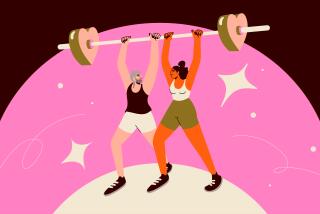Triathlete Won’t Let Fat Get in the Way of Fit
- Share via
PHOENIX — Here are some numbers on Dave Alexander, triathlete.
* Finished 276 triathlons in 37 countries in 17 years.
* Swam 9.6 miles, cycled 448 miles, ran 104.8 miles in a recent super-triathlon in eastern Hungary. His time, he says with perfect recall, was 85 hours, 46 minutes, 38 seconds.
Those are pretty remarkable numbers. But Alexander has a few more: He’s 55 years old, 5 feet, 8 inches tall and 260 pounds.
“I am fat,” he says. “I was born a big boy, and I’m always going to be big. But I’m healthy.”
Alexander’s silver hair is thinning. His bright blue eyes are going bad. His barrel stomach is getting bigger. Other triathletes often mistake him for a race organizer.
“I’m a great bar bet,” he says with a laugh. “I don’t look like I can walk across the street, let alone run a triathlon.”
Alexander attributes his great shape--corroborated by his doctor and others--to plain doggedness. He sometimes completes two triathlons in a week. He sleeps about 4 1/2 hours a night so he can put in long hours of training and work at the oil company he co-owns.
Experts say he’s just what the world needs: Someone who doesn’t let weight get in the way of physical fitness.
A surprising number of people are both fit and obese, says Steven Blair, a scientist at the Cooper Institute of Aerobics Research in Dallas and senior editor of the 1996 Surgeon General’s Report on Physical Activity and Health.
Blair recently conducted a study of obese men at the institute and found that 45% had no more than one of the major risk factors for an early death--smoking, poor eating habits, sedentary lifestyle, history of heart disease. These men, despite their obesity, had no increased mortality rate.
“Most people see an obese person walking down the street and they think, ‘This guy’s a time bomb.’ It’s not necessarily so,” Blair says.
Dave Alexander is an extreme illustration. Although technically extremely obese, his body performs at the highest levels. Obesity is usually measured by the Body Mass Index, which is calculated by dividing weight in kilograms by height in meters squared. A person--man or woman--with a BMI of 25 or higher is considered overweight; obesity occurs at BMI 30 and higher.
Alexander’s BMI is 40.
“Here’s a guy that when you see his build and body, you say, ‘How can he do this?’ ” says Andy Dzurinko, director of Arizona’s Council on Health and Physical Fitness. “But he not only does it, he does it consistently. Inside that body mass, he’s incredibly fit.”
“Dave is one in a million,” says Dr. Craig M. Phelps, Alexander’s doctor for 15 years. “And I say that statistically. I haven’t known of anyone his size who can do the swimming, the running, the cycling at the ultra-distances Dave competes at.”
Alexander, interviewed in his office, surrounded by the antique maps he collects, is wary of being called a role model.
He knows his training schedule (in a week he’ll usually swim 5 miles, run 30 and cycle 200) could kill another 260-pound, 55-year-old man.
“You don’t tell someone 100 pounds overweight to go out and run triathlons,” he says. “I’m unusual in the amount of exercise I’m capable of.”
Phelps also urges anyone overweight to consult a physician before starting an exercise program.
“People Dave’s size need to exercise,” he says. “But they need a gradual, four- or five-year horizon, instead of getting things going in a month or two.”
Alexander didn’t exercise at all until 1983, when some friends dared him to do a triathlon to lose weight.
“I was 38 years old, and these guys questioned my male ego,” he says. “I did it, and the bug bit me.”
Countless marathons and 276 triathlons later, Alexander has become a sports ambassador. Several times a year he folds his bicycle into a compact suitcase and flies overseas to race.
Blair urges a society obsessed with thinness to remember that almost half the obese men in his study were physically fit.
“People like Dave Alexander can be fat and still be healthy,” Blair says. “I am confident that there are many obese people out there who are eating a healthy diet, who exercise regularly, who don’t smoke but who are still fat. I say, lay off these people.”
For his part, Alexander marvels at his current renown. He’s been featured in documentaries, supermarket tabloids and once even as a pinup--for the month of June in a calendar put out by the weekly Phoenix New Times.
“I don’t care what people say about me,” he says, “as long as it inspires them to go out and exercise.”






